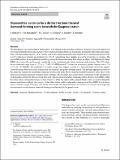Files in this item
Diamondites : evidence for a distinct tectono-thermal diamond-forming event beneath the Kaapvaal craton
Item metadata
| dc.contributor.author | Mikhail, Sami | |
| dc.contributor.author | McCubbin, Francis | |
| dc.contributor.author | Jenner, Frances | |
| dc.contributor.author | Shirey, Steve | |
| dc.contributor.author | Rumble, Doug | |
| dc.contributor.author | Bowden, Roxanne | |
| dc.date.accessioned | 2019-08-28T10:30:03Z | |
| dc.date.available | 2019-08-28T10:30:03Z | |
| dc.date.issued | 2019-08 | |
| dc.identifier | 260461507 | |
| dc.identifier | cc84e227-37ce-4553-aa9d-5660052e543c | |
| dc.identifier | 85070809453 | |
| dc.identifier | 000482400000002 | |
| dc.identifier.citation | Mikhail , S , McCubbin , F , Jenner , F , Shirey , S , Rumble , D & Bowden , R 2019 , ' Diamondites : evidence for a distinct tectono-thermal diamond-forming event beneath the Kaapvaal craton ' , Contributions to Mineralogy and Petrology , vol. 174 , 71 . https://doi.org/10.1007/s00410-019-1608-0 | en |
| dc.identifier.issn | 0010-7999 | |
| dc.identifier.other | ORCID: /0000-0001-5276-0229/work/61133199 | |
| dc.identifier.uri | https://hdl.handle.net/10023/18385 | |
| dc.description | SM and FJ are grateful to the Carnegie Institution of Washington for funding via the Carnegie Postdoctoral Fellowship programme which supported their time at the Geophysical Laboratory and the Department of Terrestrial Magnetism, respectively. FMM acknowledges funding from NASA’s Cosmochemistry program as well as NASA’s Planetary Science Research Program. SM also acknowledges funding from the NERC (NE/PO12167/1). | en |
| dc.description.abstract | The petrogenesis and relationship of diamondite to well-studied monocrystalline and fibrous diamonds are poorly understood yet would potentially reveal new aspects of how diamond-forming fluids are transported through the lithosphere and equilibrate with surrounding silicates. Of 22 silicate- and oxide-bearing diamondites investigated, most yielded garnet intergrowths (n = 15) with major element geochemistry (i.e. Ca–Cr) classifying these samples as low-Ca websteritic or eclogitic. The garnet REE patterns fit an equilibrium model suggesting the diamond-forming fluid shares an affinity with high-density fluids (HDF) observed in fibrous diamonds, specifically on the join between the saline–carbonate end-members. The δ13C values for the diamonds range from − 5.27 to − 22.48‰ (V-PDB) with δ18O values for websteritic garnets ranging from + 7.6 to + 5.9‰ (V-SMOW). The combined C–O stable isotope data support a model for a hydrothermally altered and organic carbon-bearing subducted crustal source(s) for the diamond- and garnet-forming media. The nitrogen aggregation states of the diamonds require that diamondite-formation event(s) pre-dates fibrous diamond-formation and post-dates most of the gem monocrystalline diamond-formation events at Orapa. The modelled fluid compositions responsible for the precipitation of diamondites match the fluid-poor and fluid-rich (fibrous) monocrystalline diamonds, where all grow from HDFs within the saline-silicic-carbonatitic ternary system. However, while the nature of the parental fluid(s) share a common lithophile element geochemical affinity, the origin(s) of the saline, silicic, and/or carbonatitic components of these HDFs do not always share a common origin. Therefore, it is wholly conceivable that the diamondites are evidence of a distinct and temporally unconstrained tectono-thermal diamond-forming event beneath the Kaapvaal craton. | |
| dc.format.extent | 15 | |
| dc.format.extent | 2574030 | |
| dc.language.iso | eng | |
| dc.relation.ispartof | Contributions to Mineralogy and Petrology | en |
| dc.subject | Diamond | en |
| dc.subject | Mantle petrology | en |
| dc.subject | Volatile elements | en |
| dc.subject | Stable isotopes | en |
| dc.subject | Garnet | en |
| dc.subject | Geochemistry | en |
| dc.subject | Cratonic mantle | en |
| dc.subject | GE Environmental Sciences | en |
| dc.subject | DAS | en |
| dc.subject.lcc | GE | en |
| dc.title | Diamondites : evidence for a distinct tectono-thermal diamond-forming event beneath the Kaapvaal craton | en |
| dc.type | Journal article | en |
| dc.contributor.sponsor | NERC | en |
| dc.contributor.institution | University of St Andrews. School of Earth & Environmental Sciences | en |
| dc.contributor.institution | University of St Andrews. St Andrews Centre for Exoplanet Science | en |
| dc.contributor.institution | University of St Andrews. St Andrews Isotope Geochemistry | en |
| dc.identifier.doi | https://doi.org/10.1007/s00410-019-1608-0 | |
| dc.description.status | Peer reviewed | en |
| dc.identifier.grantnumber | NE/P012167/1 | en |
This item appears in the following Collection(s)
Items in the St Andrews Research Repository are protected by copyright, with all rights reserved, unless otherwise indicated.

